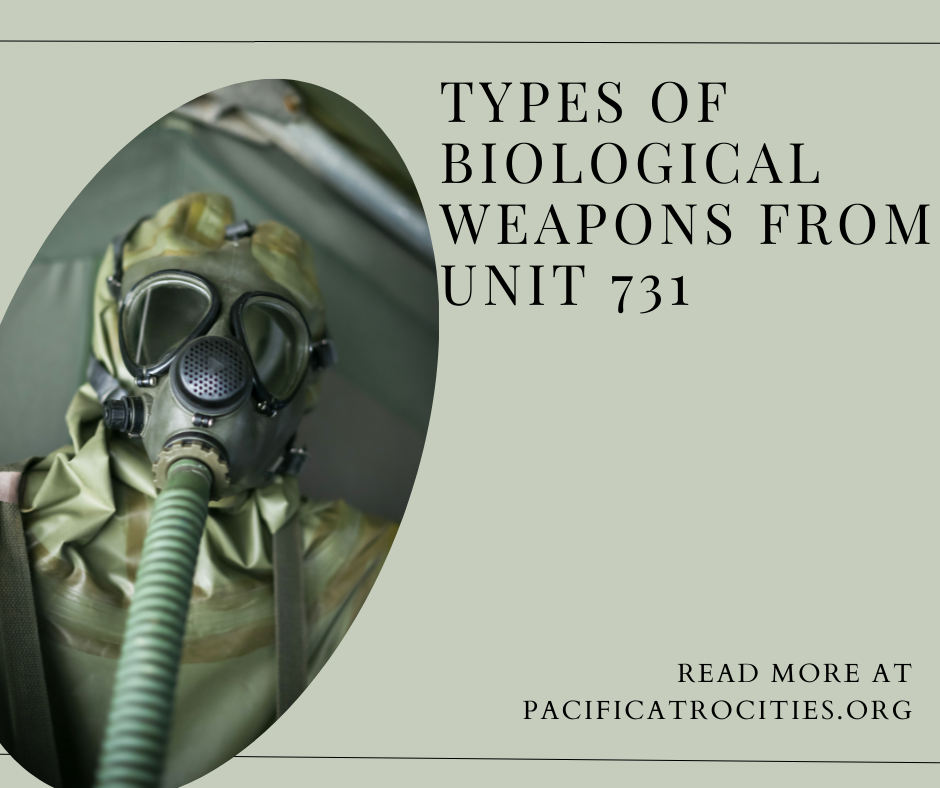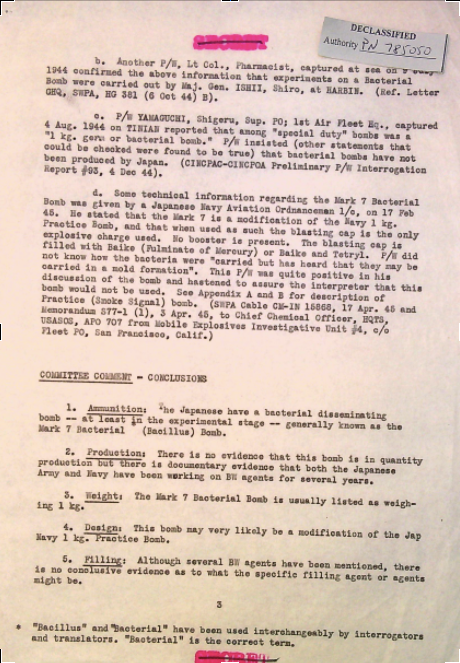|
by Evan Thompson As mentioned in the previous post, Shiro Ishii strongly believed that biological weapons were the future of warfare. Unsurprisingly, Ishii’s doctrine resulted in extensive weapons experimentation, with various ways to deliver dangerous cultures such as bubonic plague and other virulent bacteria. One such weapon came in the form of the “Mark 7” Bomb. More details about the bomb were in declassified American documents. For example, notebooks from professors captured on Kwajalein Atoll contained information regarding a “Special Bomb Mark 7.” Another notebook belonged to a Japanese flying trainee. Otokichi also contained information relating to a “Special Mark 7 Bacillus Bomb.” A US Military Intelligence publication stated that the Japanese Army and Navy both had different types of bombs. The publication found that the Japanese Naval Air Force had listed a 10 kilogram (kg) Mark 7 Bacterial Bomb, describing it as “‘a glass germ bomb for dropping in water reservoirs and cities.’” A typed order from the Secretary of the Navy Shigetaro Shimada outlined the regular pay rates for personnel based on their tasks, which included handling chemical agents to conduct research. These chemical agents were confirmed to include chemical weapons and bacteriological weapon agents. A captured POW, who was Lt. Col. Pharmacist, also corroborated the information found in the captured notebooks and admitted that Maj Gen. Shiro Ishii was conducting bacteriological bomb experiments in Harbin. Another POW, named Shigeru Yamaguchi, also confirmed the existence of experimentation on a 1kg bacteria bomb, though he maintained that Japan was not actively producing these weapons. Another captured Japanese Navy Aviation Ordnanceman claimed that the Mark 7 Bacteria Bomb was a modification of a 1kg Navy practice bomb that may carry the bacteria in the form of mold. After reviewing these reports, a US committee concluded that the Japanese were in the process of experimenting with a bacterial disseminating bomb, generally referred to as the Mark 7 Bacterial Bomb. Conclusion At the end of the war, the Americans and Soviets collectively held their trials for Japanese war crimes. MacArthur from the United States led the creation of the International Military Tribunal for the Far East (IMTFE) for the Allies to hold the Tokyo trial. However, since the allies had disagreements and mistrust due to the Cold War, the Soviets held the Khabarovsk Trial. Ultimately, the mastermind of the Japanese biological warfare machine, Ishii gained immunity in exchange for handing over his experiment findings to the Americans. The Soviet Union then held the Khabarovsk War Crimes Trial, bringing 12 workers out of the 3607 scientists in Unit 731 to trial. Though the Soviets were keen on prosecuting Ishii, the US disagreed, as Ishii’s findings were invaluable to them, especially when the US and the Soviet Union were entering the cold war era. In the US, laws were in place that prevented human experimentation by scientists and/or scientific organizations. Ishii’s research findings, which had included vast accounts of human experimentation, were seen as a treasure trove of valuable information by American scientists and were highly sought after to get ahead of the world. This has long raised the question of whether or not justice was truly served. Another controversial ruling made by the Americans was their reinstatement of Emperor Hirohito after the war. Though the extent of Emperor Hirohito’s knowledge and contribution to Ishii’s biological weapons research was unknown, it was still seen as surprising that the Americans would allow Hirohito to stay in power. Reasons for this decision are unknown, though American anti-communist sentiments likely had something to do with the decision, as dethroning Hirohito and creating a power vacuum would leave postwar Japan vulnerable to Soviet influence, something the Americans would be worried about. Though Hirohito may not have known about the true work of Ishii and his subordinates, the fact remains that Hirohito was complicit in Ishii’s atrocities in the sense that he provided Ishii with the necessary resources required for him to conduct his disturbing human experimentation and biological weapons research. The exoneration of both Ishii and the Emperor seems to point towards the lack of justice served to those who were victims of Ishii’s reign of terror and the Emperor’s willingness to support it. Learn more about Unit 731:
1 Comment
John Perretti
6/24/2024 12:07:44 pm
Looking for images of terracota plague bombs of WWII Japan.
Reply
Leave a Reply. |
- Home
- Stories
-
Internship
- Summer 2024 Internship
- Summer 2023 Internship
- Fall 2022 Internship
- Summer 2022 Internship
- Summer 2021 Internship
- Fall 2020- Spring 2021 Internship
- Summer 2020 Internship
- Fall 2019 Internship
- Summer 2019 Internship >
- School Year 2018-2019 Internship
- Summer 2018 Internship >
- Fall 2017 Internship
- Summer 2017 Internship >
- Books
- Archives
-
Resource Page
-
Supplementary Research Guides
>
- Unit 731 - Guide >
-
Philippines' Resistance - Guide
>
- Philippines World War II Timeline
- The Japanese Invasion & Conquest of the Philippines
- Bataan Death March
- Formation of Underground Philippines Resistance
- Supplies of the Guerrilla Fighters
- The Hukbalahap
- Hunter's ROTC
- Marking's Guerrillas
- United States Army Forces in the Philippines of Northern Luzon (USAFIP-NL)
- The Aetas
- Chinese and Filipino-Chinese Nationalist Guerrilla Units
- The Female Faces of the Philippine Guerrillas
- Rising Sun Flag - Guide >
- Pinay Guerrilleras - Guide >
- Fall of Singapore - Guide >
- Three Years and Eight Months - Guide >
- Siamese Sovereignty - Guide >
- The Khabarovsk War Crimes Trial - Guide >
- Unit 731 Cover-up : The Operation Paperclip of the East - Guide >
- Marutas of Unit 731 - Guide >
- Prince Konoe Memoir - Guide >
- Competing Empires in Burma - Guide >
- Battle of Shanghai - Guide >
- Ishi Shiro - Guide >
- Taiwan The Israel of the East - Guide >
- Seeking Justice for Biological Warfare Victims of Unit 731 - Guide >
- Rice and Revolution - Guide >
- Clash of Empires - Guide >
-
Hunger for Power and Self-SufficiencyI - Guide
>
- The Influence of War Rations on Post-War Culinary Transformations
- How World War II Complicated Food Scarcity and Invention
- American Military Innovations
- Government-Sponsored Food Inventions in Europe during World War II
- Feeding the Army: The Adaptation of Japanese Military Cuisine and Its Impact on the Philippines
- Mixed Dishes: Culinary Innovations Driven by Necessity and Food Scarcity
-
Denial A Quick Look of History of Comfort Women and Present Days’ Complication - Guide
>
- The Comfort Women System and the Fight for Recognition
- The Role of Activism and International Pressure
- The Controversy over Japanese History Textbooks
- The Sonyŏsang Statue and the Symbolism of Public Memorials
- Activism and Support from Japanese Citizens
- The Future of Comfort Women Memorials and Education
- Echoes of Empire: The Power of Japanese Propaganda - Guide >
- Lesson Plans >
-
Supplementary Research Guides
>
|
Pacific Atrocities Education
730 Commercial Street San Francisco, CA 94108 415-988-9889 |
Copyright © 2021 Pacific Atrocities Education.
We are a registered 501 (c)(3) charity. |
- Home
- Stories
-
Internship
- Summer 2024 Internship
- Summer 2023 Internship
- Fall 2022 Internship
- Summer 2022 Internship
- Summer 2021 Internship
- Fall 2020- Spring 2021 Internship
- Summer 2020 Internship
- Fall 2019 Internship
- Summer 2019 Internship >
- School Year 2018-2019 Internship
- Summer 2018 Internship >
- Fall 2017 Internship
- Summer 2017 Internship >
- Books
- Archives
-
Resource Page
-
Supplementary Research Guides
>
- Unit 731 - Guide >
-
Philippines' Resistance - Guide
>
- Philippines World War II Timeline
- The Japanese Invasion & Conquest of the Philippines
- Bataan Death March
- Formation of Underground Philippines Resistance
- Supplies of the Guerrilla Fighters
- The Hukbalahap
- Hunter's ROTC
- Marking's Guerrillas
- United States Army Forces in the Philippines of Northern Luzon (USAFIP-NL)
- The Aetas
- Chinese and Filipino-Chinese Nationalist Guerrilla Units
- The Female Faces of the Philippine Guerrillas
- Rising Sun Flag - Guide >
- Pinay Guerrilleras - Guide >
- Fall of Singapore - Guide >
- Three Years and Eight Months - Guide >
- Siamese Sovereignty - Guide >
- The Khabarovsk War Crimes Trial - Guide >
- Unit 731 Cover-up : The Operation Paperclip of the East - Guide >
- Marutas of Unit 731 - Guide >
- Prince Konoe Memoir - Guide >
- Competing Empires in Burma - Guide >
- Battle of Shanghai - Guide >
- Ishi Shiro - Guide >
- Taiwan The Israel of the East - Guide >
- Seeking Justice for Biological Warfare Victims of Unit 731 - Guide >
- Rice and Revolution - Guide >
- Clash of Empires - Guide >
-
Hunger for Power and Self-SufficiencyI - Guide
>
- The Influence of War Rations on Post-War Culinary Transformations
- How World War II Complicated Food Scarcity and Invention
- American Military Innovations
- Government-Sponsored Food Inventions in Europe during World War II
- Feeding the Army: The Adaptation of Japanese Military Cuisine and Its Impact on the Philippines
- Mixed Dishes: Culinary Innovations Driven by Necessity and Food Scarcity
-
Denial A Quick Look of History of Comfort Women and Present Days’ Complication - Guide
>
- The Comfort Women System and the Fight for Recognition
- The Role of Activism and International Pressure
- The Controversy over Japanese History Textbooks
- The Sonyŏsang Statue and the Symbolism of Public Memorials
- Activism and Support from Japanese Citizens
- The Future of Comfort Women Memorials and Education
- Echoes of Empire: The Power of Japanese Propaganda - Guide >
- Lesson Plans >
-
Supplementary Research Guides
>



